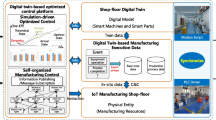Abstract
In networked manufacturing systems, shop floors that are geographically dispersed can coordinate autonomously to complete the fabrication and assembly of products. It is a type of self-organizing production process, in which the scheduling of those shop floors must be synchronized, in terms of time and quantity. In this paper, we propose a time-synchronizing control policy for self-organizing shop floors based on the (max, +) system theory, prove the convergence of the synchronization algorithm, and verify the effectiveness of the algorithm by numerical experiments. Besides, a method of implementing the synchronizing control system based on the radio frequency identification (RFID) technologies is also proposed briefly.
Similar content being viewed by others
References
Baccelli F., Cohen G., Olsder G.J., Quadrat J.-P. (1992) Synchronization and linearity—an algebra for discrete event systems. Wiley, New York
Bousbia, S. (2002). Self-organization in distributed manufacturing control: State-of-the-art and future trends. In Proceedings of the IEEE International Conference on Systems, Man and Cybernetics(Vol. 5, pp. 661–666).
Bussmann, S., & Schild, K. (2000). Self-organizing manufacturing control: An industrial application of agent technology. In Proceedings of the Fourth IEEE International Conference on Multi-agent Systems (pp. 87–94).
Chappell, G., Durdan, D. G., Gibert, G. L., Ginsburg, J. S., & Tobolski, J. (2002). Auto-ID on delivery: The value of Auto-ID technology in the retail supply chain. Auto-ID Center, November 1, 2002.
Chow H.K.H., Choy K.L., Lee W.B., Lau K.C. (2006) Design of an RFID-case-based resource management system for warehouse operations. Expert Systems with Applications 30(2): 561–576. doi:10.1016/j.eswa.2005.07.023
Cohen G., Moller P., Quadrat J.-P., Viot M. (1989) Algebraic tools for the performance evaluation of discrete event systems. Proceedings of the IEEE 77(1): 39–58. doi:10.1109/5.21069
Cohen G., Gaubert S., Quadrat J.-P. (1999) Max-plus algebra and system theory: Where we are and where to go now. Annual Reviews in Control 23(1): 207–219. doi:10.1016/S1367-5788(99)00023-1
D’Amours S., Montreuil B., Lefrancois P., Soumis F. (1999) Networked manufacturing: The impact of information sharing. International Journal of Production Economics 58: 63–79. doi:10.1016/S0925-5273(98)00088-7
De Schutter B., van den Boom T. (2001) Model predictive control for max-plus-linear discrete event systems. Automatica 37: 1049–1056. doi:10.1016/S0005-1098(01)00054-1
Estrem W.A. (2003) An evaluation framework for deploying web services in the next generation manufacturing enterprise. Robotics and Computer Integrated Manufacturing 19: 509–519. doi:10.1016/S0736-5845(03)00061-9
Huang G.Q., Zhang Y.F., Jiang P.Y. (2007) RFID-based wireless manufacturing for walking-worker assembly islands with fixed-position layouts. Robotics and Computer-Integrated Manufacturing 23(4): 469–477. doi:10.1016/j.rcim.2006.05.006
Huang G.Q., Zhang Y.F., Jiang P.Y. (2008) RFID-based wireless manufacturing for real-time management of job shop WIP inventories. International Journal of Advanced Manufacturing Technology 36: 752–764. doi:10.1007/s00170-006-0897-4
Liu, M. R., Zhang, Q. L., Ni, L. M., & Tseng, M. M. (2004). An RFID-based distributed control system for mass customization manufacturing. In J. Cao et al. (Eds.), Lecture Notes on Computer Science (Vol. 3358, pp. 1039–1049).
Lu B.H., Bateman R.J., Cheng K. (2006) RFID enabled manufacturing: fundamentals, methodology and applications, International Journal of Agile Systems and Management 1(1): 73–92
McFarlane D., Sarmab S., Chirna J.L., Wonga C.Y., Ashtonb K. (2003) Auto ID systems and intelligent manufacturing control. Engineering Applications of Artificial Intelligence 16: 365–376. doi:10.1016/S0952-1976(03)00077-0
Pétin J.F., Gouyon D., Morel G. (2007) Supervisory synthesis for product-driven automation and its application to a flexible assembly cell. Control Engineering Practice 15: 595–614
Poon T.C., Choy K.L., Lau H.C.W. (2007) A real-time shop floor control system: an integrated RFID approach. . International Journal of Enterprise Network Management 1(4): 331–349
Qiu R.G. (2007) RFID-enabled automation in support of factory integration. Robotics and Computer-Integrated Manufacturing 23: 677–683
Tharumarajah A. (2003) A self-organizing view of manufacturing enterprises. Computers in Industry 51(2): 185–196
Thorne, A., McFarlane, D., Hodges, S., Smith, S., Harrison, M., Brusey, J., & Garcia, A. (2003). The Auto-ID automation laboratory: Building tomorrow’s systems today. White Paper, CAM-AUTOID-WH-018.
Wang X.F. (2002) Complex networks: Topology, dynamics and synchronization. International Journal of Bifurcation and Chaos 12(5): 885–916
Wang X.F., Chen G. (2002a) Synchronization in small-world dynamical networks. International Journal of Bifurcation and Chaos 12(1): 187–192
Wang X.F., Chen G. (2002b) Synchronization in scale-free dynamical networks: robustness and fragility. IEEE Transactions on Circuits and Systems—I: Fundamental theory and applications 49(1): 54–62
Wang X.F., Chen G. (2002c) Pinning control of scale-free dynamical networks. Physica A 310: 521–531
Author information
Authors and Affiliations
Corresponding author
Rights and permissions
About this article
Cite this article
Wang, Z., Cao, Z. Time-synchronizing control of self-organizing shop floors for networked manufacturing. J Intell Manuf 21, 647–656 (2010). https://doi.org/10.1007/s10845-009-0240-7
Received:
Accepted:
Published:
Issue Date:
DOI: https://doi.org/10.1007/s10845-009-0240-7




